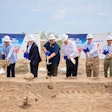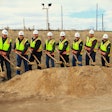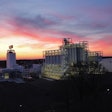State of the art ultrasonic level measurement equipment was installed in 1997 on 42 silos at Cargill’s Irving Elevator in Portland, Oregon. The equipment was to provide level data to an existing PLC which would then use the data for alarm and control and make the data available to a graphic display in the control room which was being added as part of the level measurement system. The goal was to improve utilization of the silos and decrease demurrage fees on rail cars and ships by speeding loading, unloading and blending operations.
The silos are 127 ft tall, both round and interstice of various shapes, with cone and offset cone bottoms. The primary criteria in selecting the ultrasonic transducers was the silo height which resulted in selecting transducers operating at 13 kHz. Lower frequency transducers generally are larger and have more power than higher frequency transducers.
Set up of the ultrasonic units was very time consuming both for the instrument vendor and the customer and was performed intermittently over several months. All measurement points were working satisfactorily at the end of this period.
Over time, some measurement points had recurring problems with erratic readings. The readings would jump downward several feet from the true reading and return to the correct reading as grain was move in and out of the bin. Some of the ultrasonic units were changed out to yoyo type mechanical level transmitters.
Level revisited:
In October of 2009, a dust collection system was added at the Irving Elevator, now a part of CLD Pacific Grain, and the level technology discussion was reopened, primarily for the two 45 ft tall screening bins. One bin was for dust and the other contained wheat and chaff. In 2010 a 25GHz loop powered radar unit was installed on the dust bin (Figure 1) with mixed results.
The loop powered unit was moved to a wheat bin and a 4 wire 25 GHz unit installed on the dust bin to provide more power to penetrate the dust. The 4 wire 25 GHz unit was then moved to another wheat bin, and a 78 GHz unit installed on the dust bin. More 78 GHz units have since been installed on wheat bins.
The 78 GHz units are loop powered with a range of 100 meters and a 4º beam angle. The power and frequency aid the unit in penetrating dust and provide a strong return signal with minimum skip.
One yo yo type mechanical level transmitter has been replaced with a 4 wire 25 GHz unit and the others will be replaced with the 78 GHz units as needed.
Progress:
The ultrasonics level transmitters were the economical solution at the time they were installed and remain the most economical for many applications.
On tall grain silos physics work against reliable operation. Lower frequencies are required for longer range transducers used in tall silos and dusty bins. As the wavelength increases in relation to the grain size of the material being measured signal skip becomes more problematic.
Radar behaves in an opposite way to ultrasonic. As the frequency increases, smaller horns can be used allowing for lighter, easier to install units. Range increases and beam angle decreases with higher frequencies and the wavelength decreases.
Decreasing the wavelength relative to the grain size of the material being measured allows for reflections from the individual grains to return directly to the instrument which results in strong direct echoes and scattered indirect echoes. Wave lengths which are long in comparison to the grain size cause the signal to skip off the bulk surface causing indirect echoes which can be relatively strong in comparison to the desired direct echoes. Skip is more noticeable in large diameter bins where the difference in return time is greater. Performance on the wheat bins benefits greatly from the decreased wavelength.
Performance in the dust bin in Figure 1 benefits from the fact that Increasing the frequency of the microwave signal also increases its ability to penetrate dust and light build up on the transmitter lens. The narrow beam angle makes start up easier by reducing reflections from the hanging balls shown in the picture and advance echo processing takes care of the rest of the false echoes.
Conclusion:
Radar has advanced rapidly over the last few years, in part because much of the echo processing abilities of the newer units rely heavily on lessons learned with the ultrasonics units. Ultrasonics technology was around for years before signals could be stored and process digitally, something taken for granted with current radar technology. Methods for viewing and manipulating echo profiles and detection algorithms were already in use before the current generation of radar entered the picture.
Figure 1 also illustrates another phenomenon in improved technology. As improved technology makes the tough applications routine, the new technology is asked to perform in even tougher environments.
In 1997 when the 42 level transducers were first installed the best that could have been said of the dust bin would have been “Well, if you really want to try it…..”
Glossary:
Skip – As applied to non-contacting level measurement, occurs when the transmit signal hits the material surface at an angle and the beam splits with part of the beam returning directly and the rest of the signal returning along one or more indirect paths.
Beam angle – The specified angle of the transmit signal measured from the -3 dB point on one side of the transmitted beam to the -3 dB point on the other side of the transmitted beam.
Ultrasonic – Signals commonly in the range from 20 kHz to 10 MHz. In long range level measurement may range from below 10 kHz to beyond 60 kHz.
Acknowledgements:
Todd Hunt of Branom Instruments who persevered to provide his customer with the right technology and provided the dust bin photograph.

















